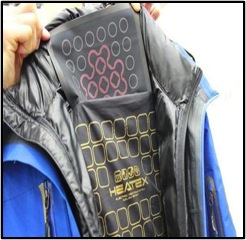
IFAI’s market research manager Jeff Rasmussen says that the worldwide smart fabrics market is growing at an annual rate of about 18 percent from about $984 million in 2011 to a projected $1.9 billion in 2015. Rasmussen spoke on “Current Developments in the Smart and Interactive Fabrics Market” Oct. 7 at IFAI’s Advanced Textiles Conference in Anaheim, Calif.
Transportation (largely because of inflatable seatbelts and heated seats) leads with 27 percent of the market; military and government is close behind with 21 percent, and construction infrastructure holds about 20 percent. Sports and fitness represents about 17 percent of the market with wearable electronics for sports and fitness monitoring. In fact, it is sports and fitness that showed the highest growth rate, worldwide, for 2014. Growth in fashion at 27 percent and medical/health care at 33 percent, were keeping pace with the market leaders.
Advances in nanotechnology are impacting the smart textiles market by incorporating nanoparticles into fabrics to enhance or change properties such as fire resistance, electronic or conductive capabilities and monitoring. Rasmussen cited developments underway for military uses, which could include, for example, uniforms that change color to match the environment, and lightweight battlesuits that incorporate health monitors and communication equipment.
In health and wellness settings, nanomaterials could also respond to injuries by delivering drugs or facilitating sensors that could alert health care providers of blood clots, or even specific diseases.
Nanomaterials in some form will contribute $1 trillion to the U.S. economy in 2015, Rasmussen reports. Western European countries, Japan and the U.S. are investing similarly, together representing about 75 percent of the nanomaterial economy.

U.S. Military influence
Although U.S. Military spending on clothing and other textiles is decreasing overall, there is a healthy interest in advanced textiles used in applications such as tents, with fabrics that provide solar-powered electricity, for example, and tent seams that repel water.
The Defense Advanced Research Projects Agency (DARPA), through it’s Warrior Web Program, has been hard at work for several years developing an “exoskeleton suit” that is soft, low-powered and can enhance a soldier’s physical capabilities dramatically.
Furthermore, there is promise, although longer term, of a smart uniform that would provide chemical and biological agent protection using a carbon nanotube fabric. Research is underway at the Calif.-based Lawrence Livermore National Laboratory in collaboration with MIT and others.
Smart successes
A variety of technologies that have application in multiple segments have had market acceptance; Rasmussen offered a few examples:
- Colo.-based Outlast® Technologies phase-change materials, originally developed for NASA, is now used in body armor for police officers made by U.S. Armor to offer lighter weight and temperature regulation.
- British company D30 has a product called Aero D30®Smart Skin, a lightweight, impact-protection layer that can be applied to fabrics. The normally soft material becomes rigid under a high-impact force and returns to its soft state after the impact passes. Although it was developed mostly for the sportswear market, it has application for the military, police and industrial protective wear.
- Austria-based Provlies GmbH has a geosynthetic material equipped with an RFID tag that can be used for tracking road resurfacing data. The geosynthetic is rolled out in between the roadbed and the new asphalt applied in road repair.
- South Korea’s Kolon Glotech Inc. has a heat-generating clothing textile that uses a conductive polymer to create heat. Named HEATEX, the fabric heats up uniformly and can be controlled with a smartphone app.
- Omsignal, based in Montreal, Canada, has exercise shirts with sensors that track a variety of data, transmit it to a software cloud and then to a mobile app.
Rasmussen says that most health plans cover the LifeVest* made by Pittsburgh, Pa. company, ZOLL. The vest is, in fact, a wearable defibrillator—the first to be worn outside the body rather than implanted. It continuously monitors the patient’s heart with dry, non-adhesive sensing electrodes to detect life-threatening abnormal heart rhythms.

Not there yet
There are some interesting new technologies under development, as well, Rasmussen points out, including a European project called HARKEN (Heart and Respiration In-Car Embedded Non-intrusive sensors) for a seatbelt and car seat cover that’s designed to alert drowsy drivers by measuring the driver’s vital signs and emitting audible and/or tactile alarms if the driver is in danger.
Scientists at the University of Illinois have developed an ultrathin, skin-mounted electronic patch that could be used to monitor the brain, heart, and other muscle activity in a noninvasive way. The electronic components are embedded on a sheet of rubber that matches the thickness and elasticity of the skin. The patch could also help patients with muscular or neurological disorders to communicate via computers or even to distinguish muscle movement in the throat and feed signals to a computer that recognizes speech.
Future growth
Smart fabrics including wearable technologies are poised to show rapid growth in the future, says Rasmussen. Market drivers today will continue to influence this progression:
1. The Military, particularly for power sources
2. Technology-savvy younger populations that expect instant connectivity, speed and multi-functionality in communication
3. A burgeoning elderly population that will benefit from more health-related advanced technologies.
Interest in research in flexible electronics, specifically, will continue to be strong, as well as fabrics that incorporate sensors and monitors using Bluetooth Low-Energy (BLE) technology.
With an anticipated world population of 9.7 billion by 2050—75 percent of whom will be living in cities—the ability of smart textiles to help meet the needs of this high population concentration will be important long into the future.
Jeff Rasmussen is market research manager for IFAI. Janet Preus is senior editor of Advanced Textiles Source.
 TEXTILES.ORG
TEXTILES.ORG


